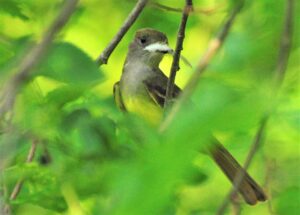Photography courtesy of Lowell Washburn, all rights reserved.
The melody was diagnostic. A great crested flycatcher was singing from the treetops. I couldn’t see the bird, of course. Inhabiting the uppermost layers of the forest canopy, the species’ whereabouts is usually obscured by summer vegetation. This is one bird that is definitely more often heard than seen. Consequently, most folks remain unfamiliar with Iowa’s largest flycatcher and would likely be surprised to learn how many were living nearby.

Similar in size and somewhat similar in shape to the eastern kingbird, the great crested flycatcher sports an olive back, rusty –colored tail, and distinctive lemon-yellow belly. Great crested are cavity nesters, utilizing a variety of sites including natural cavities, abandoned woodpecker holes, nest boxes, and even open drainpipes or downspouts. If nesting cavities are deep, birds will often fill them nearly to the brim with twigs, bark or coarse grasses. Once completed, the nest cup is furnished with feathers, fine greenery, and tattered strips of plastic sacks or cellophane food wrappers.
Flycatchers are aggressive defenders of territory and are successful at keeping most nest competitors at bay. This, along with the fact that the great crested will inhabit woodlands of all sizes, has allowed Iowa populations to remain stable. Although this year’s nesting cycle is complete for most pairs, the feather carrying bird in the attached photo is apparently giving it one more try before departing for the Central American wintering grounds.

 Tom Cope
Tom Cope Sue Wilkinson
Sue Wilkinson Susan Judkins Josten
Susan Judkins Josten Rudi Roeslein
Rudi Roeslein Elyssa McFarland
Elyssa McFarland Mark Langgin
Mark Langgin Adam Janke
Adam Janke Joe Henry
Joe Henry Kristin Ashenbrenner
Kristin Ashenbrenner Joe Wilkinson
Joe Wilkinson Dr. Tammy Mildenstein
Dr. Tammy Mildenstein Sean McMahon
Sean McMahon